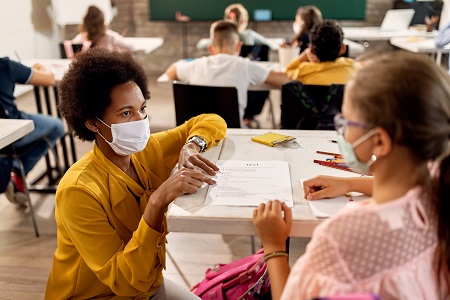
December 2, 2020 | Amy Rambo
Teachers need both appreciation and real support during COVID-19
Researchers are only beginning to understand the ramifications of the coronavirus pandemic on the education landscape. Without question, it means rapid change nationwide for 2021’s classrooms. It also means that educators may need more support and help than ever before.
A recent Yale study broke down the health concerns of faculty and leadership: the danger of the virus itself, work-life balance, a lack of governing support, and the loss of loved ones to COVID–19. Meanwhile, instructors found themselves criticized as new platforms and models were implemented, sometimes haphazardly, in a shifting environment.
These factors have been a recipe for teacher burnout. "I have NEVER been this exhausted," tweeted one veteran high school English teacher in New Jersey working in a hybrid–learning model. "This is not sustainable."
As a result, some school districts are taking a proactive approach to supporting the mental health of their educators through a variety of channels.
Growing Focus on Educator Well–Being
Kaiser Permanente has partnered with a Washington, D.C.–area school district to focus on the well-being of educators through tools such as a mental health boot camp and virtual "shake off the anxiety" dance parties.
Principals have also reported success implementing social–emotional learning to strengthen connections with students – a proven boost to teacher wellness. Taking their cue from the business world, some states and districts are offering more professional development opportunities to retain their best talent.
On social media, teachers share tips on podcasts like "The Anxiety Coach" and other self–care resources to help them cope day to day – a trending need that could open the door to more collaborations with districts on longer–term solutions.
Evolving Needs and Opportunities for Support
"My district has no Social Studies curriculum," a fourth-grade teacher recently shared online, "... but I’m expected to teach it for 45 minutes daily in this new virtual school schedule. ... At this point, I’m fine with spending money on premade units just so I don't have to be anxious or stressed. Send help."
K–12–focused businesses offering professional development, virtual curriculum assistance and other digital resources for distance learning, such as integrated grading and communication platforms, could help districts reassure teachers going into a new year. What will ultimately be most effective is providing educators with the tools they need to do their jobs well – and safely.
An NPR poll reported that 78% of teachers were concerned about having sufficient amounts of personal protective equipment (PPE) and cleaning supplies. Teachers spent an average of $450 of their own money for classroom supplies even prior to the pandemic, according to the Economic Policy Institute, and are facing additional out–of–pocket expenses for COVID–19 prevention.
Overwhelmingly, teachers are crying out for solutions. Software that works. A safe working environment. Better ways to communicate with parents. Curriculum ideas and resources for taking advantage of the virtual space. As schools shut down over winter break, districts will take the opportunity to reassess and upgrade their resources, providing opportunities to shape future classrooms and marketplaces.
Keeping schools running smoothly is all about putting the right tools in educators’ hands. To get your ideas in front of educational decision-makers, reach out to MCH today.
Need More Time?
Due to inactivity, you will be logged out within 5 minutes.
To stay logged in, please select Stay Logged In.





 Logout
Logout